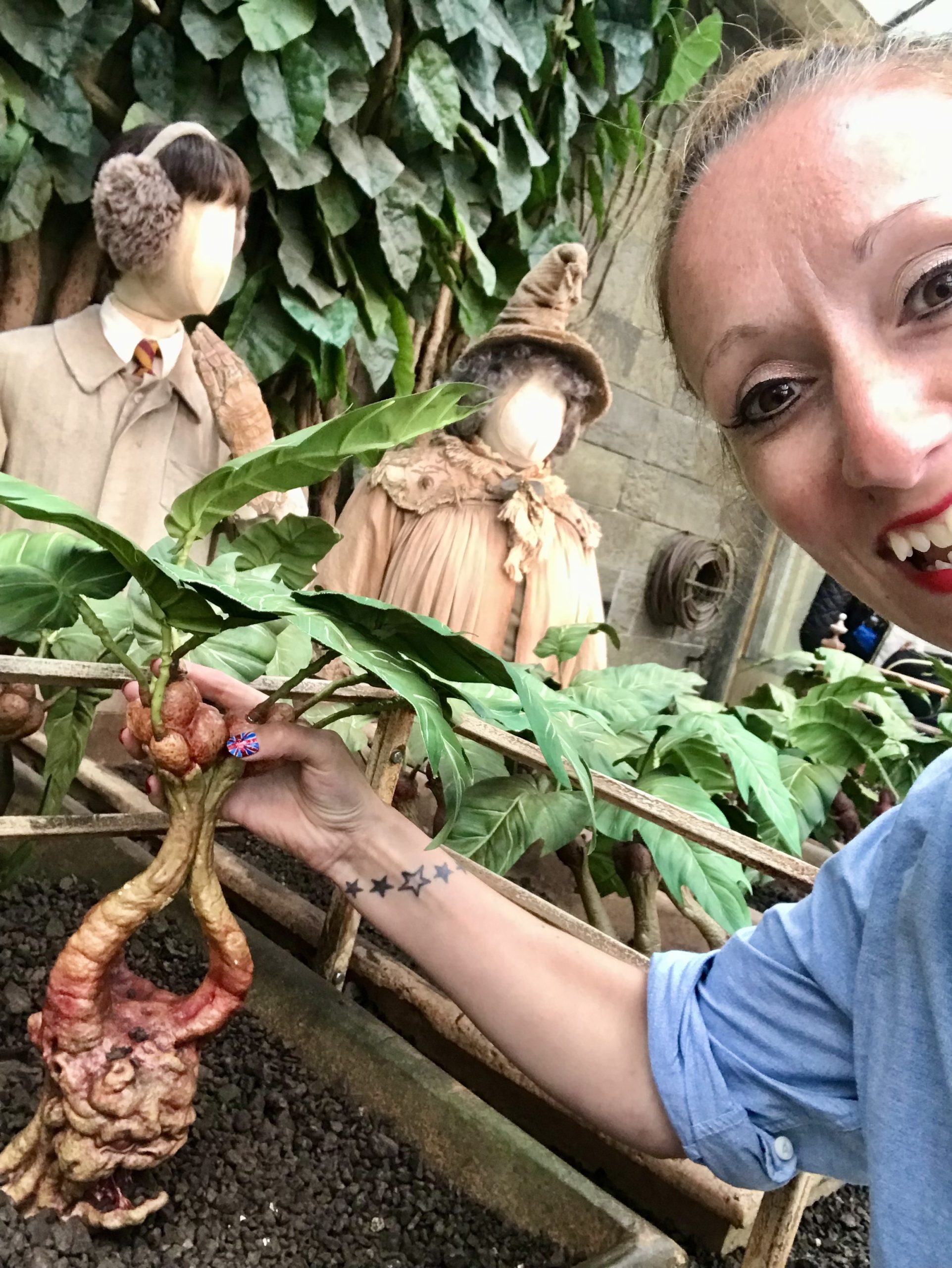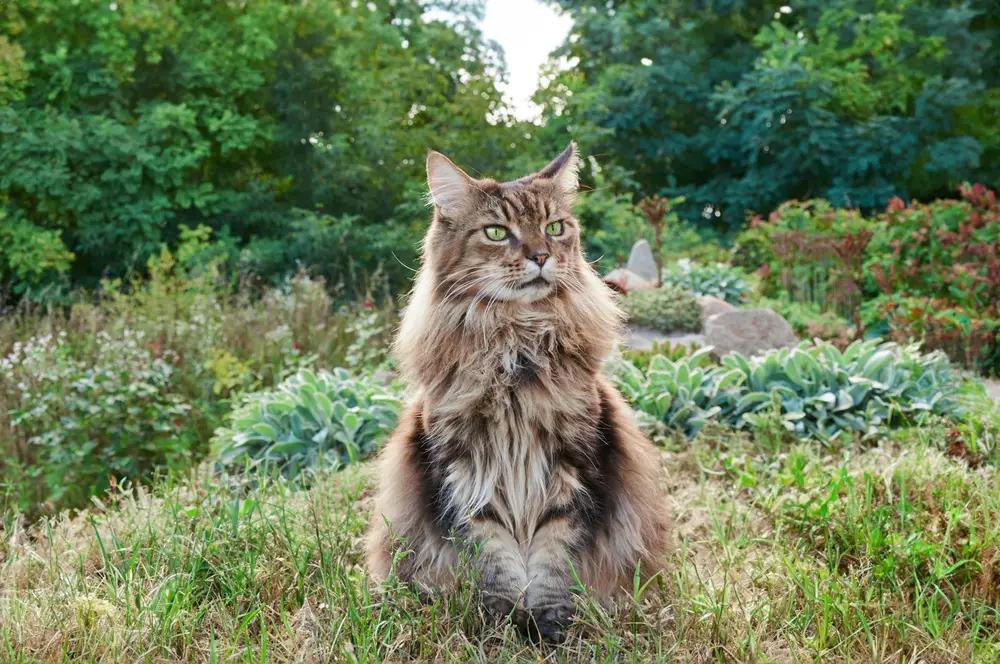There is nothing worse than creating a beautiful flower garden only to find cats have used it as their personal litter box! An effective and environmentally friendly way is to use fragrant plants to keep cats away.
While I love cats, I understand that unwanted feline visitors in your garden can cause damage and disruption. Fortunately, there are plants to keep cats away and other unwanted visitors. Fortunately, These plants, with their strong aromas, not only deter cats but also invite desirable visitors like pollinators.
Here, we’ll explore how to strategically use fragrant plants that repel cats, the top 19 plants we recommend, as well as the use of essential oils and homemade sprays to reinforce your garden’s defenses.
Understanding Cat Behavior
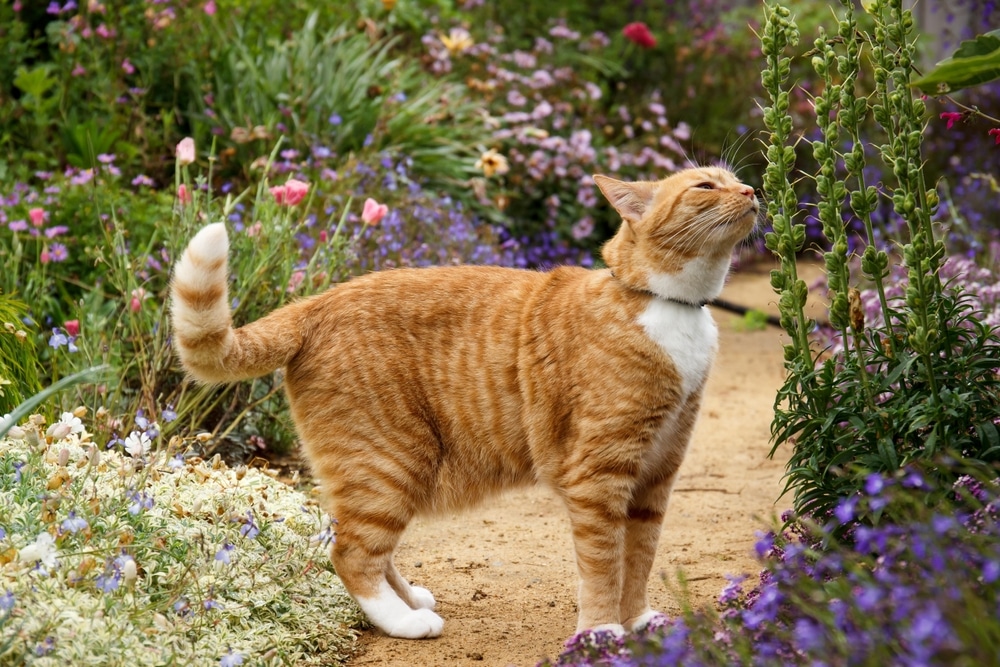
Why Are Cats Attracted To Plants?
Exploration and Hunting: Cats are naturally curious and enjoy exploring their environment. Sometimes they bat at leaves, chew on stems, or even dig in the soil as part of their play.
Sensory Stimulation: Some plants emit scents or textures that cats find intriguing. Others can work as cat-deterring plants with strong aromas.
Food: Cats may chew on grass or other plants as a way to aid their digestion. The fiber in plants can help induce vomiting, which can help cats clear out indigestible material like hairballs.
Environment: Cats like to create a sense of security by finding hiding spots. They might find the perfect spot among the foliage.
Common Cat Behaviors In Gardens
Digging: Sometimes cats dig in garden beds out of curiosity or as part of their play behavior. Other times, they dig because they are using it as their toilet!
Scratching: Anyone who has had a cat knows that they love scratching! They do it to mark territory, sharpen their claws, and stretch their muscles. Garden plants and trees, especially those with rough textures, are perfect scratching posts.
Chewing: Some cats may nibble on plants out of curiosity or to get some fiber. If you want to do cat-friendly gardening, you need to make sure you know which plants are safe and which are toxic.
Playing: Cats might simply be playing! They can pounce on plants or chase insects that are on them. It’s a great game for them, unfortunately not for your flowers!
R&R: Cats like nothing better than a good snooze. Gardens provide lots of comfy sunny spots for lounging and sunbathing.
How To Use Fragrant Plants Effectively To Keep Cats Away
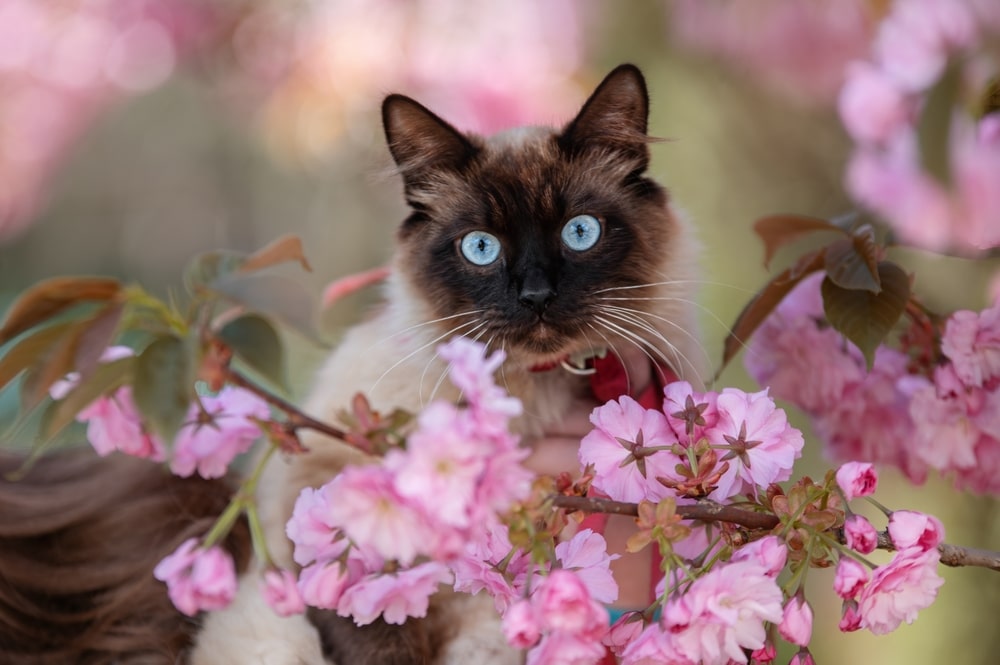
Using fragrant plants effectively in your garden, especially when you have cats around, involves strategic planning and consideration of both your plants’ benefits and your feline friends’ safety. Here’s some tips:
Strategy: Ask yourself these questions:
- What parts of your garden do you want to keep cats away from?
- What type of area is it?
- Flowers
- Vegetables
- Herbs
- Seating area
- How busy will it be?
Answering these questions will help you choose the appropriate plants. For example, if it’s a high-traffic area you will want to avoid plants that you also don’t like the smell of, perhaps the scaredy cat plant or the curry herb plant. Planting pleasing aromatic plants like rosemary or lavender would be a better option if they are likely to be brushed often.
Companion Planting: Combine fragrant plants that repel cats with those that attract beneficial insects. For example, planting lavender alongside marigolds can deter cats while attracting bees.
Border Plants: Plant fragrant herbs, flowers, or shrubs along the edge of your garden or flower bed to create a scented barrier. This helps deter cats from entering the space.
Essential Oils & Sprays: Increase the defenses around your garden by using fragrant oils and sprays. For example, mix essential oils such as peppermint, lavender, or any citrus with water in a spray bottle. Apply this mixture to the areas you wish to keep cats away from.
Cat-Friendly Gardening Tips
Another option is to create safe spaces for cats in your garden where they can rest and play. This way they will spend their time in that area and stay away from your flower garden!
- Choose cat-safe plants in this area to avoid accidental ingestion. Catnip and cat grass are great choices!
- Include climbing areas and scratching posts
- Provide shelter
Tips For Safe Cat Repellent Gardening
- Placement: Strategic placement of fragrant plants around your garden, borders, flower beds, and vulnerable areas where cats are most likely to venture.
- Combination: Use multiple plants for enhanced deterrence
- Maintenance: Regular care and pruning to maintain plant health and scent
- Safety: Ensure plants are non-toxic to both cats and humans
19 Cat Repellent Plants
Here are our top 19 plants that cats don’t like:
1 – Citronella
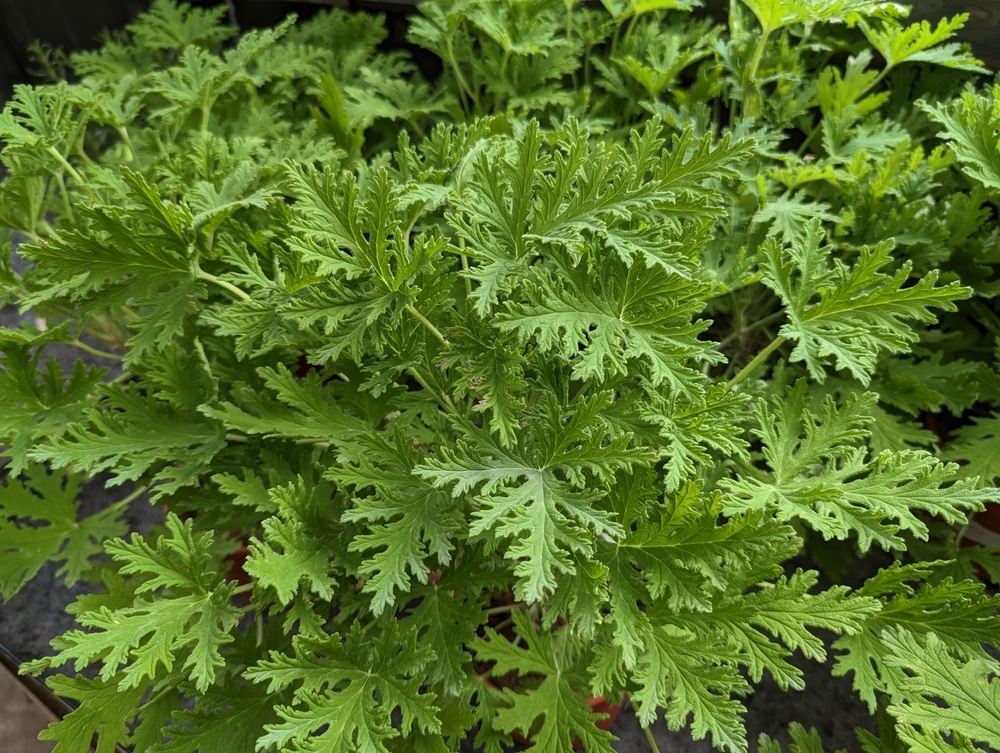
| Scientific Name | Pelargonium citrosum |
| Scent | Lemon geranium |
| Other uses | Excellent mosquito repellent |
Cats generally have a strong aversion to the citronella plant, which is renowned for its potent citrus scent. Citronella is also used in insect repellents as it has a powerful aroma. It is in the same family as geranium but not the same as citronella grass.
This natural repellent can serve as an effective deterrent, helping to keep cats away from specific areas of your garden.
In addition to repelling cats, citronella is also highly effective in keeping away pesky bugs like mosquitoes. Every summer I have lots of citronella plants in pots on my deck and balconies!
2 – Lemongrass
| Scientific Name | Cymbopogon spp. |
| Scent | Citrus |
| Other uses | Insect repellent, Culinary |
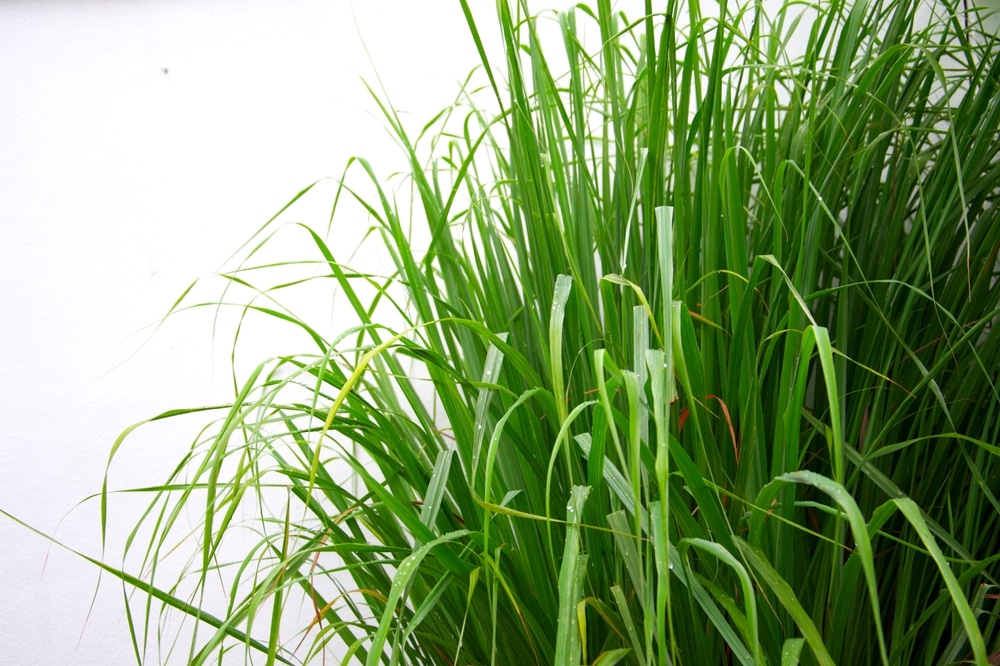
While lemongrass is used in cuisines worldwide, it is also effective at keeping cats away.
It works as an insect repellent as well. The plant, its scent, and its extract are widely used in toiletries such as soaps, shampoos, and cosmetics.
It’s a great all-round plant to include in your garden.
3 – Lavender
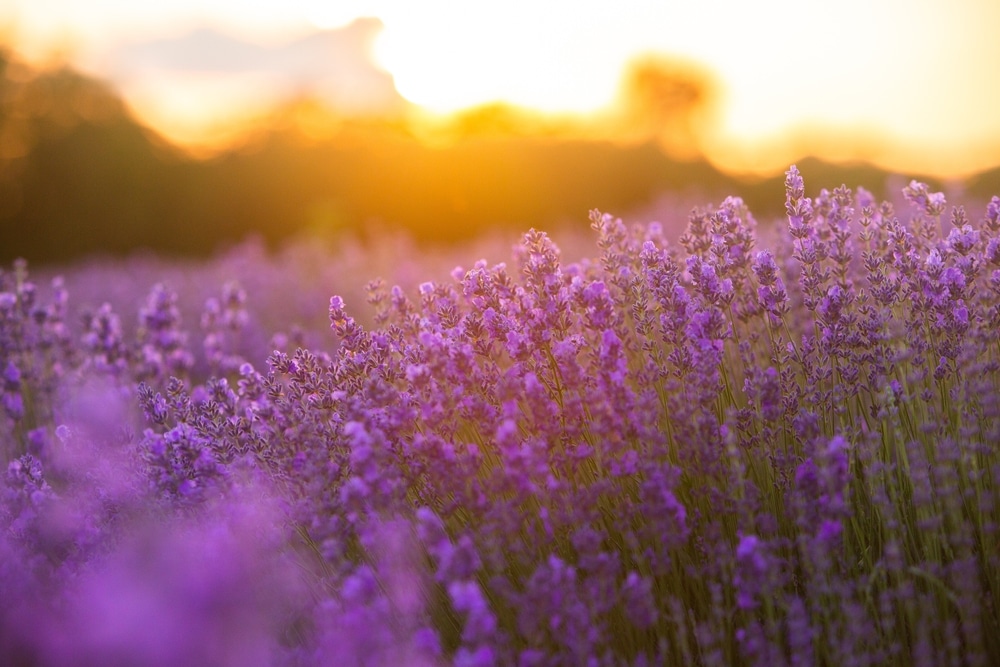
| Scientific Name | Lavandula |
| Scent | Herbal, floral, sweet |
| Other uses | Ornamental, essential oils, medicine, people pleaser! |
This well-known plant has many uses!
Not only is it beautiful to look at, but lavender plants are known to keep cats away. Consider adding some to your garden beds.
This plant is also widely used in cosmetic, toiletry, and fragrance products. Cutting a few flowering stems and drying them in your house adds a delightful aroma to your space.
4 – Rosemary
| Scientific Name | Salvia rosmarinus |
| Scent | Herbal, camphor, pine, citrus |
| Other uses | Culinary, people pleaser! |
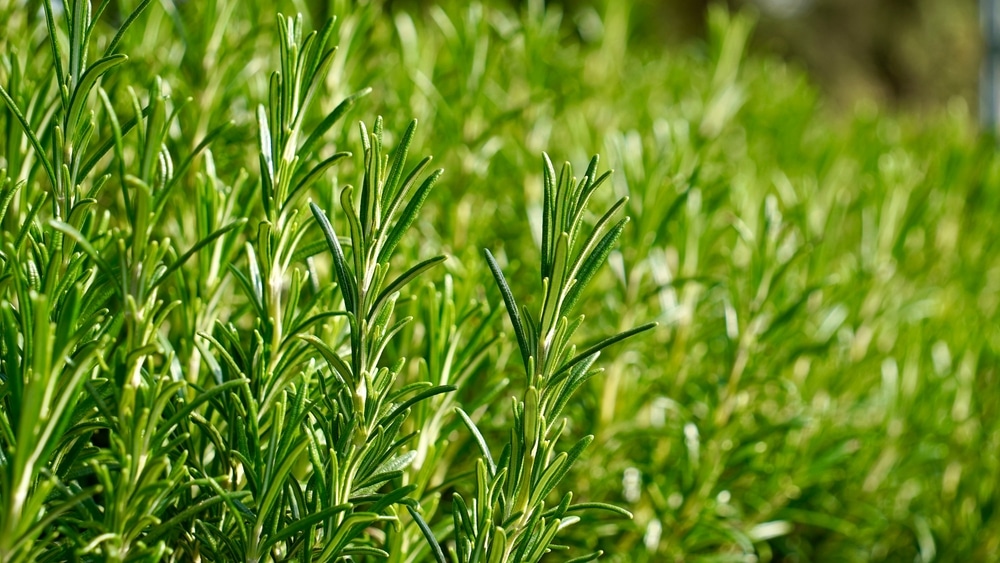
Roasted cherry tomatoes with rosemary, focaccia with garlic and rosemary, potatoes sautéed with rosemary – I love cooking with rosemary!
But did you know that it’s also a good plant to keep cats away? Originating in the Mediterranean, rosemary likes sunshine and heat. It does grow well in pots, so try that if you need to move inside over winter.
5 – Lemon Thyme
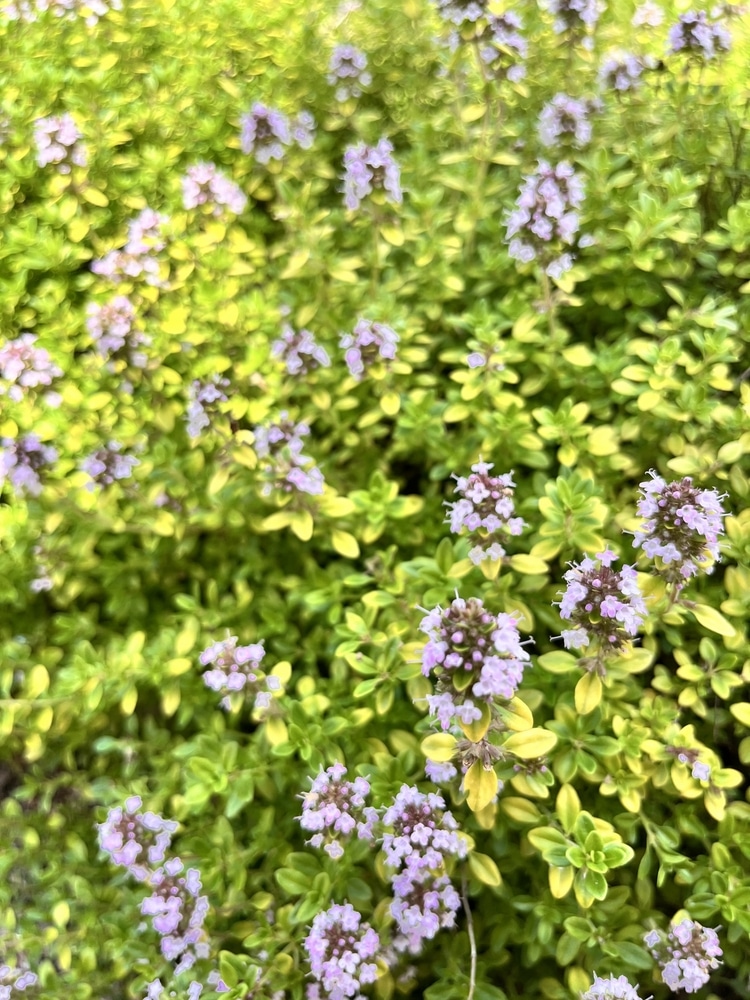
| Scientific Name | Thymus citriodorus |
| Scent | Citrus, herbal |
| Other uses | Culinary, insect repellent |
Lemon thyme is a low-growing herb, it works well as ground covers or at the front of garden beds.
Cats do not like the smell of this plant, so it works well as a border plant to keep them from venturing further.
The added bonus of growing lemon thyme is you have it on hand for cooking!
It’s a big hit with pollinators too. What’s not to like?!
6 – Oregano
| Scientific Name | Origanum vulgare |
| Scent | Camphor, aromatic |
| Other uses | Culinary |

Another fantastic kitchen herb, I always grow oregano. You can grow it in garden beds or in pots, making it a versatile addition to your garden.
Like the other herbs, the pungent aroma of oregano works well to repel cats and keep them from roaming through your flower garden.
7 – Lemon Balm
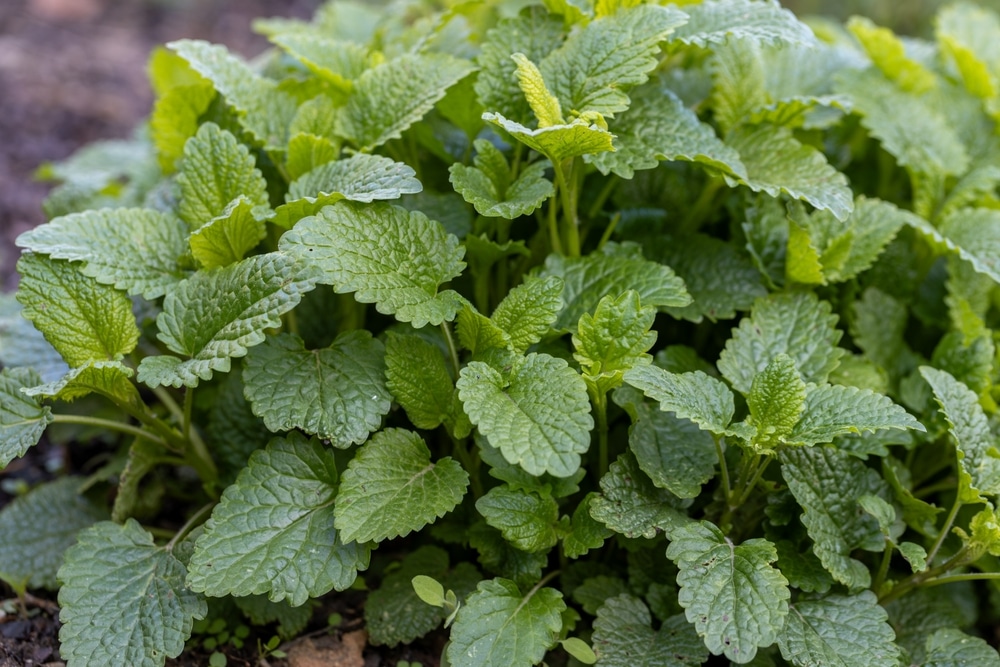
| Scientific Name | Melissa officinalis |
| Scent | Citrus |
| Other uses | Insect repellent, Culinary |
Like lemon thyme, lemon balm is great for attracting beneficial pollinators while repelling adventurous felines. They find the citrusy aroma repulsive!
Lemon balm prefers it a little shady so it’s a great choice for spots in your garden that don’t get full sun. Opt for positions where it gets morning sun and more shade in the bright afternoon sun.
It’s great for cooking and steeping in teas.
8 – Geranium
| Scientific Name | Pelargonium |
| Scent | Citrus, fruit, rose |
| Other uses | Ornamental, beautiful flowers, keeps bugs away |

Now the scent of geranium can repel some people as much as it repels cats! Its strong aroma seems to divide people’s opinions. So make sure you know the scent before you choose to plant lots in your garden!
There are lots of geranium varieties to choose from and many produce the most beautiful flowers. So you’ll have something lovely to look at while keeping the cats away!
9 – Scaredy Cat Plant
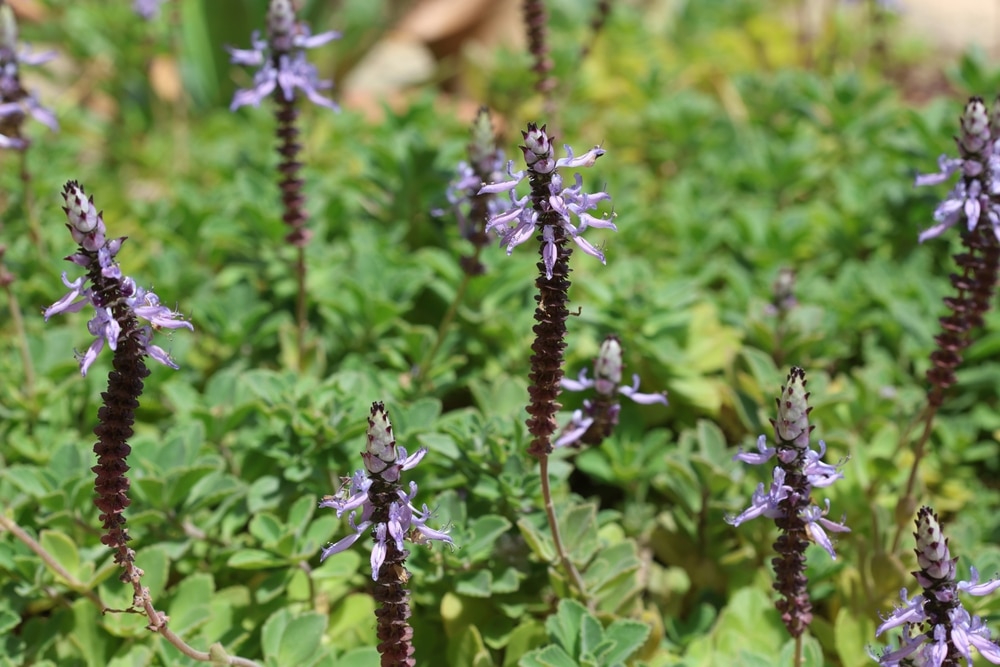
| Scientific Name | Coleus caninus |
| Scent | Pungent! Skunk, urine |
| Other uses | Ornamental, strong odor so strategic planting necessary, deters other unwanted visitors |
The story goes that this plant smells so foul that it’s enough to scare off cats, dogs, rabbits, and other unwanted animals!
Its pungent aroma is increased when anything brushes and bruises the leaves.
It’s a very easy plant to grow and will take root almost anywhere it is planted. However, due to its strong skunk-like odor, you will want to plant this one strategically!
10 – Curry Herb Plant
| Scientific Name | Helichrysum italicum |
| Scent | Curry, sage |
| Other uses | Culinary uses, essential oils |
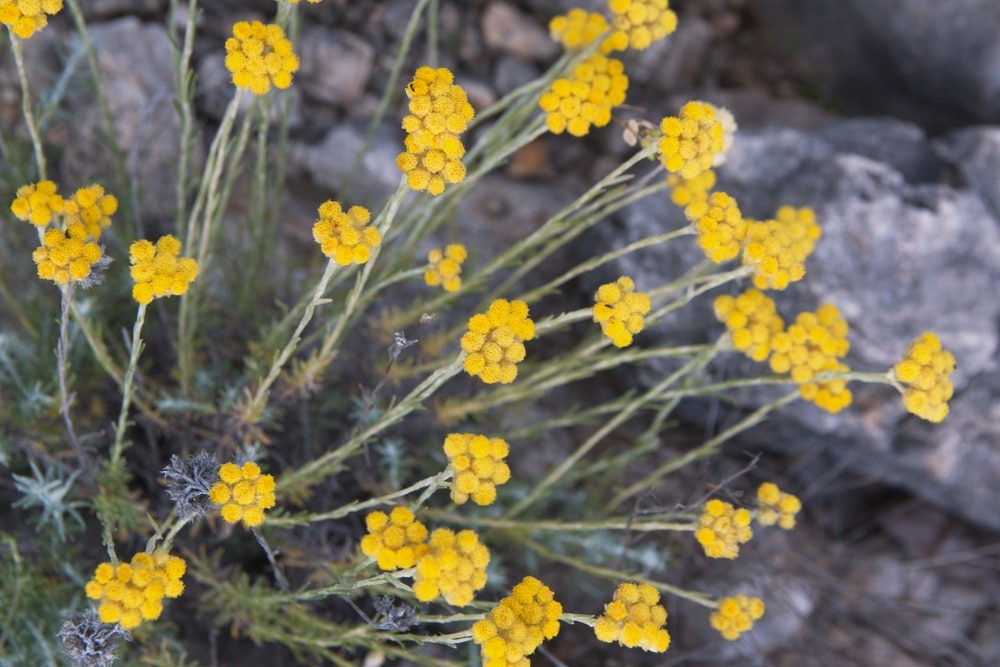
To clarify this isn’t the plant that produces curry powder. It is the curry tree that produces the leaves that are commonly used in Indian cuisine.
The curry herb plant is a herb that can be used in cooking but is mainly chosen as an ornamental plant. It has attractive silvery spiky leaves.
It has a very pungent aroma that cats hate, so it is a good choice if you are trying to keep them away.
As with other plants, make sure you can tolerate the scent before planting it. You can opt to grow it in a pot so it is easily movable.
11 – Common Rue
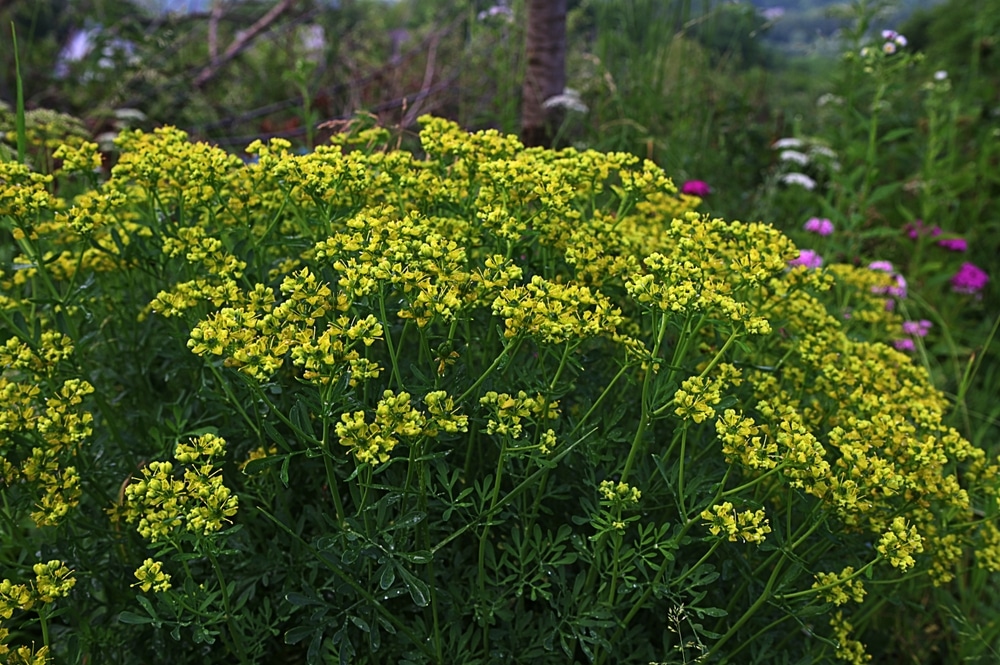
| Scientific Name | Ruta graveolens |
| Scent | Musty, light citrus |
| Other uses | Ornamental, insect repellent, |
Cats really dislike common rue’s musty aroma.
It is an attractive blue-green shrubby herb that has small, delicate flowers that come in white, yellow, and pink. They are hardy plants to grow and do well in poor soil.
CAUTION:
Do be aware that common rue is now regarded as toxic to humans and animals if consumed in large quantities. It was once used in medicine and cooking but it is no longer recommended because of this fact.
The oils on the leaves can also cause skin irritation so always wear gloves when handling this plant.
12 – Roses
| Scientific Name | Rosa |
| Scent | Floral |
| Other uses | Lots! Including ornamental, potpourri, medicine, culinary |
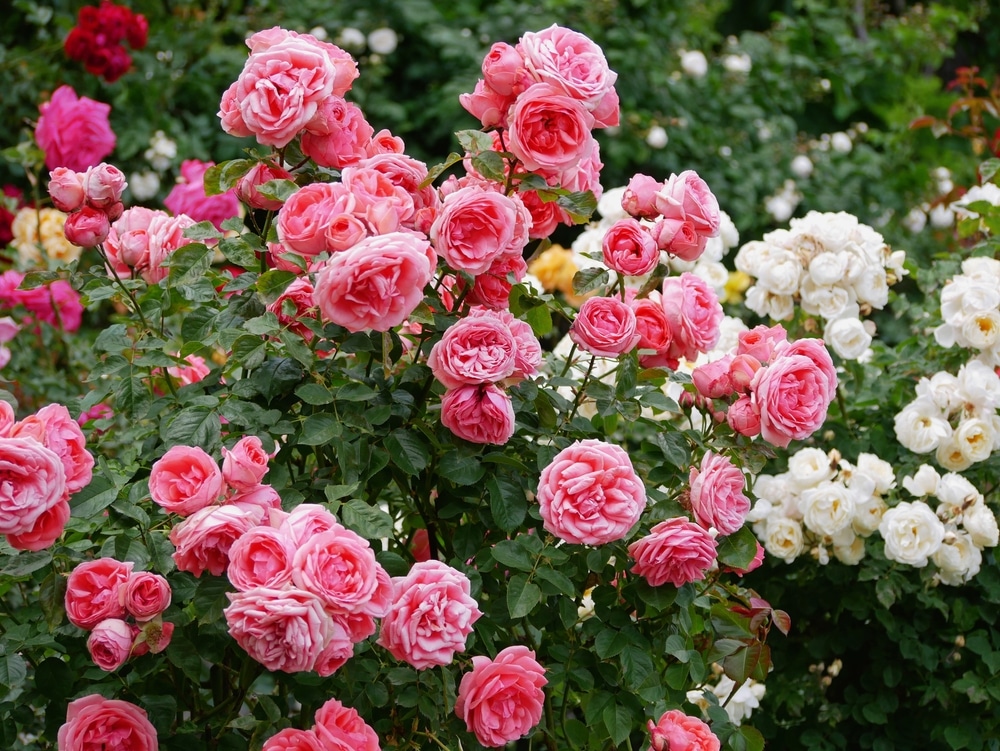
Now roses act as a plant to keep cats away not necessarily because of their fragrance but because their thorny shrubbery makes the environment uninviting to our friendly felines!
So you can plant roses strategically to keep cats from entering certain outdoor areas.
13 – Coffee Plants
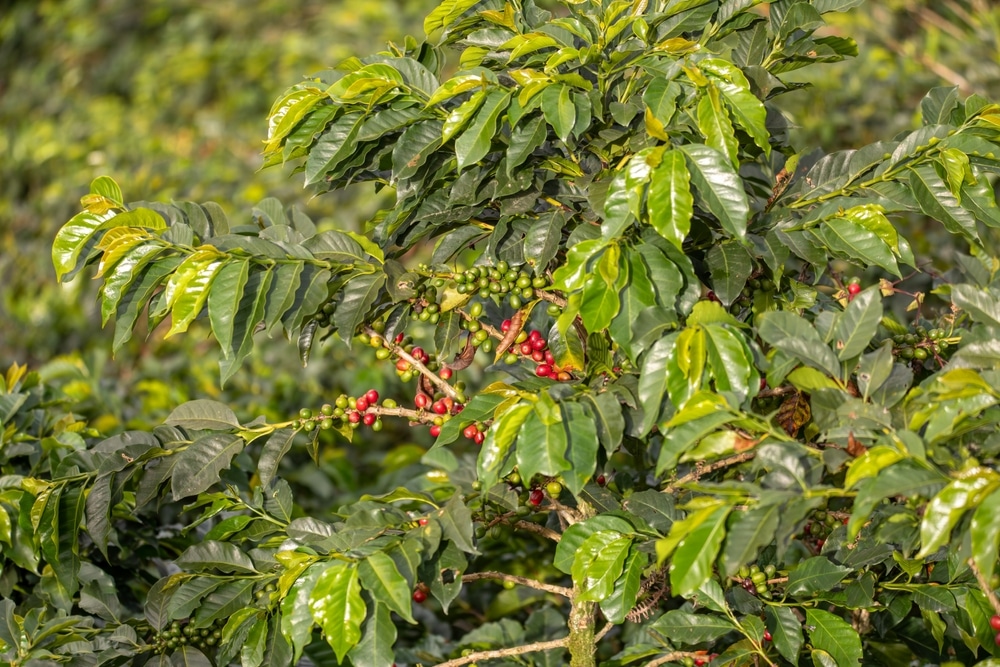
| Scientific Name | Coffea arabica |
| Scent | Jasmine |
| Other uses | Ornamental, Culinary |
Cats certainly don’t like coffee plants. You do need to be aware that they can be dangerous if consumed by the cats. So be careful where you plant them.
It is an attractive plant with shiny green leaves and delicate white flowers that have a lovely fragrance. The flowers then turn into green fruits that ripen to red. Inside these fruits is where you’ll find your coffee beans!
15 – Sweet Mock Orange
| Scientific Name | Philadelphus coronarius |
| Scent | Citrus |
| Other uses | Ornamental, people pleaser! |
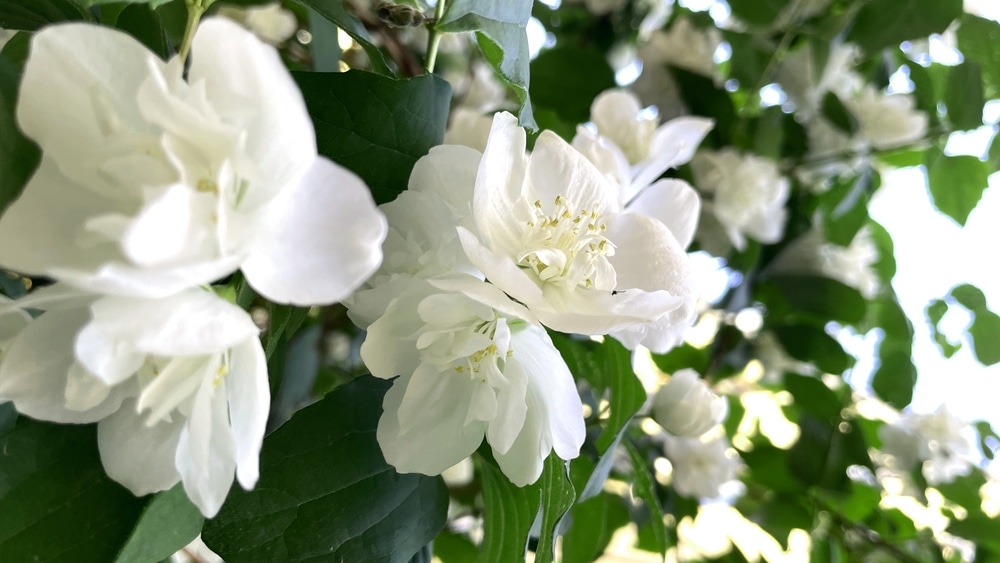
Sweet mock orange is a shrub that can grow up to 10 feet (3.04 meters). So make sure when you plant it that it will have enough room to grow.
Clusters of small white flowers form along the branches making it a very attractive addition to any garden. The flowers produce a strong citrus aroma which cats find unappealing.
It’s another great choice if you want to attract pollinators and repel cats.
16 – Orange Jessamine

| Scientific Name | Murraya paniculata |
| Scent | Orange, jasmine |
| Other uses | Ornamental, small, humans love the smell! |
Orange jessamine makes a great border shrub. So consider planting this if you want an aromatic fence to keep felines away.
It produces beautiful white flowers with long petals that curl back. The scent given off by the flowers is a mix of orange and jasmine. Sounds delightful to us but not to our feline friends!
17 – Mexican Orange
| Scientific Name | Choisya |
| Scent | Citrus |
| Other uses | Ornamental, attracts pollinators, people enjoy it! |
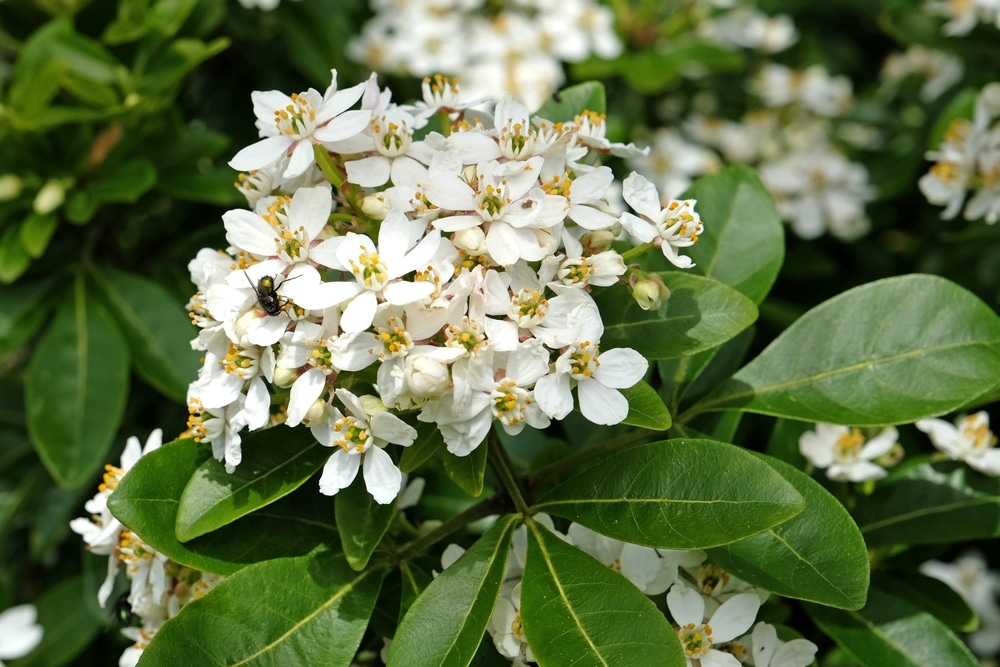
Another of the shrub plants that keep cats away but work well to attract butterflies and other pollinators.
It can grow up to 10 feet (3.04 meters) both in height and width. It likes sheltered spots in the garden.
It has little white star-shaped flowers. The whole plant emits a citrus aroma if bruised. Cats certainly don’t like it.
18 – Pennyroyal
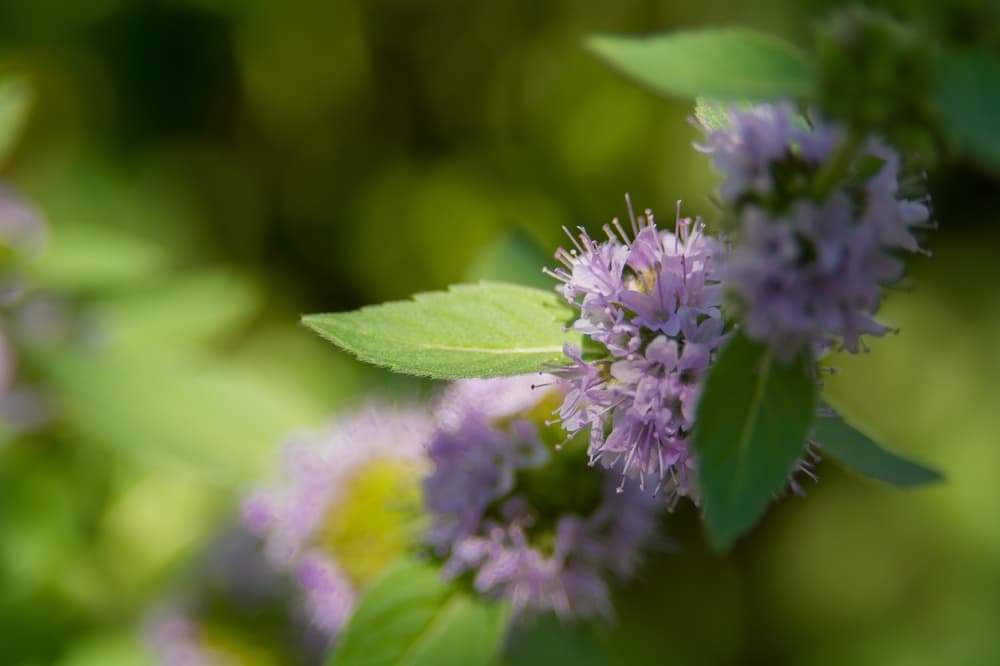
| Scientific Name | Mentha pulegium |
| Scent | Mint, spearmint |
| Other uses | Medicine |
As part of the mint family, pennyroyal does a good job of repelling cats with its spearmint aroma.
There are two varieties: a European pennyroyal plant and an American pennyroyal plant. Both emit a mint scent but it is worth noting that the European species can (like other mints) spread very quickly, so consider planting in pots so you have more control.
CAUTION:
Historically, it was widely used in herbal remedies and medicine. However, it has now been established that the oils from the plant can be very harmful to humans and animals. So take care in choosing where to plant it.
19 – Japanese Cheesewood
| Scientific Name | Pittosporum tobira |
| Scent | Sweet, citrus |
| Other uses | borders (hedges), ornamental, nice smell to humans! |
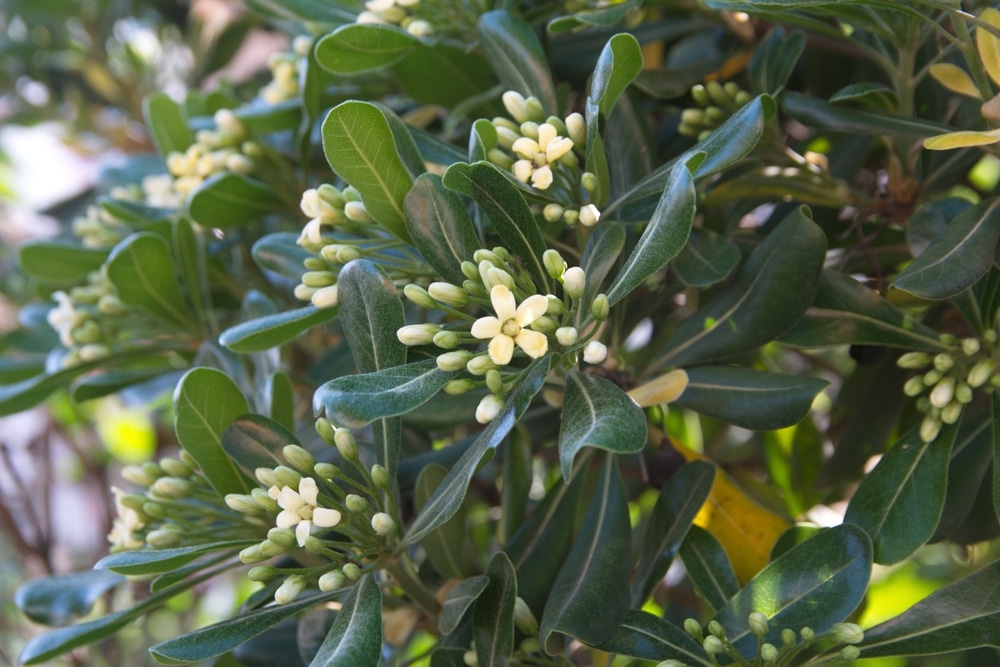
This is a good choice for borders, fragrant hedges, and it even grows into a tree. Dwarf varieties are also available.
It is native to Japan and Eastern Asia Japan but grows well elsewhere around the world.
Clusters of flowers with long white or cream petals grow at the end of branches. Its flowers have a sweet citrus fragrance that cats cannot stand!
